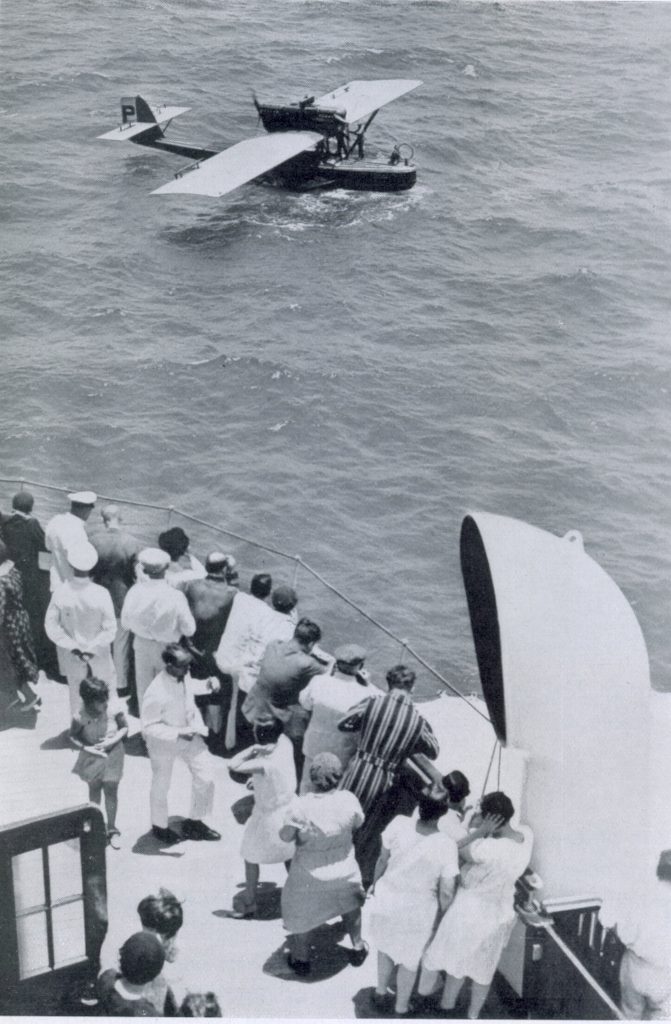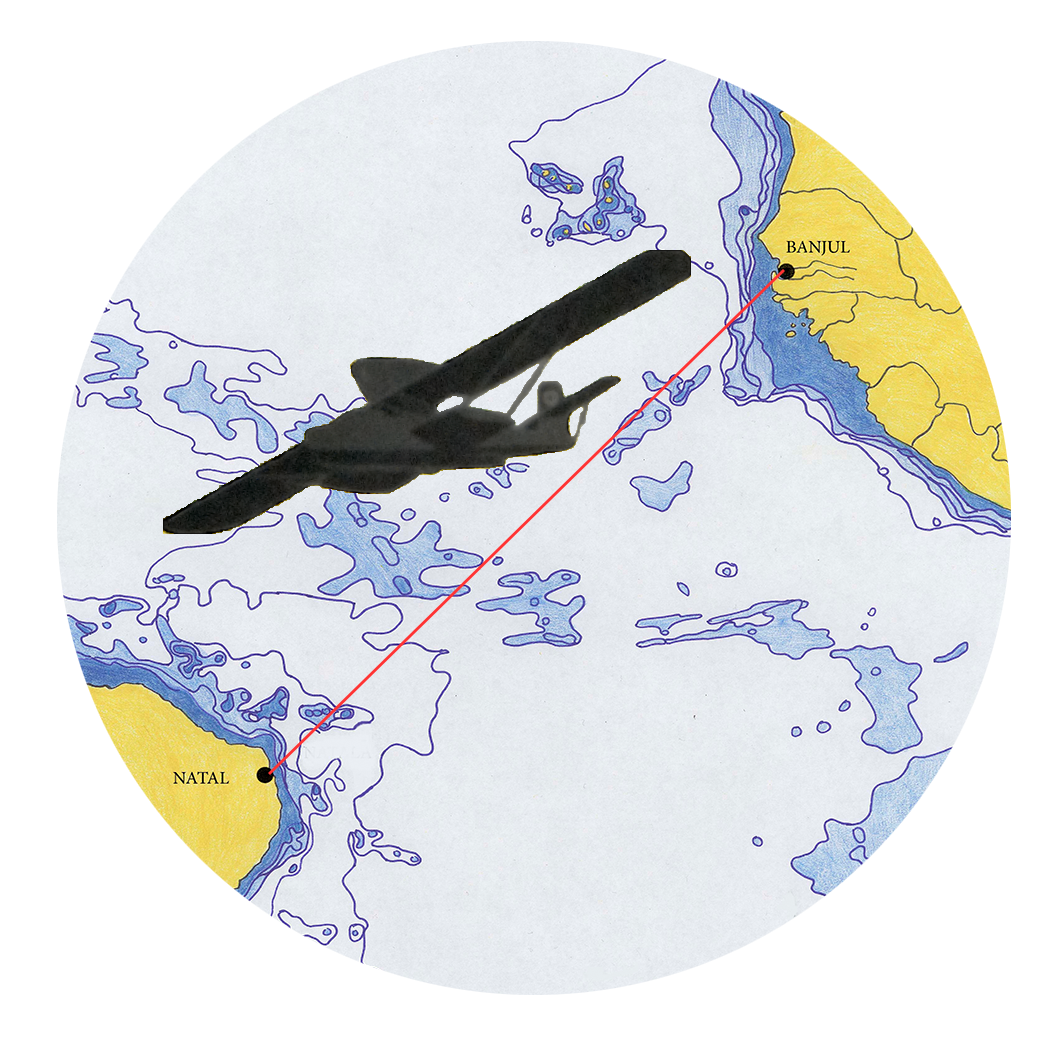During the earlier days, the route from Europe to South America was divided into three distinct parts.
The first leg from Berlin to the Canary Islands was operated by the Deutsche Luft Hansa. On the flight from Berlin to Cadiz regular and fast planes were used whereas sea planes covered the route between Cadiz and Las Palmas on the Canary Islands.
The mail was then transferred to the liner “Cap Polonio” or “Cap Arcona”. Once the liners came close to Fernando de Noronha a Dornier Wal flying boat left Rio de Janeiro for Fernando de Noronha were the mail was handed over. The Wals were operated by the Syndicato Condor Ltda covering the last leg.
On the way to Europe the Wals brought the mail to Fernando de Noronha were it was picked up by one of the liners on their way to the Canary Islands.
Using this combined mail service resulted in a delivery time 4 to 5 days faster than by regular service.
The Dornier Wal shown in the picture is believed to be the “Olinda”. It crashed on Sept 11, 1931 while taking off on the Rio Potengi in Natal. Only one member (Paul Hein) of the German crew (Max Christian Sauer, Rudolf Karwat, Franz Noether, Paul Hein) survived. The Rampa Foundation has an article about the crash on it’s web site.

Cap Arcona and Dornier Wal “Olinda” from the Syndicato Condor off Fernando de Noronha
In 1931 the Do-X (call sign D-1929) crossed the South Atlantic for the first time. After leaving Lisbon she flew to Bolama in Guinea-Bissau via Puerto de la Luz and Villa Cisneros (Spanish Sahara) now Dakhla. The flight to Porto Praia (Cabo Verde) was heavily delayed because the tropical conditions and the weight of the flying boat thwarted every takeoff for 3 weeks. Eventually the Do-X flew to Natal in Brasil via Porto Praia and Fernando de Noronha arriving on June 5 1931.
This event lays a foundation for the next phase…
The Deutsche Luft Hansa conducted three test series starting on May 29 1933 to establish the viability of a mail service across the South Atlantic. The third trial ended on January 31 1934 shortly before opening up for regular service.
Because of the distance between the nearest points of Africa and South America it was not possible to cross the Atlantic using land planes. The concept was therefore based on Dornier Wal flying boats and a depot ship equipped with a catapult and stationed in mid ocean.
The trials were carried out using two 8 ton Wals (Passat / D-2068 and Monsun / D-2069) and a 10 ton Wal (Taifun / D-2399). These flights showed that a mail route across the South Atlantic could be established. Only the Passat was thereafter used during the scheduled mail flights. The tests showed also that water takeoffs decreased flight distances. It also meant that the Wals could transport less mail because of weight restrictions during takeoff. A lot of horse power was needed to lift the flying boat out of the water. Once out of the water it was useless in order to fly to your destination. As it was the case with the Do-X tropical conditions could make it difficult to do a water takeoff. The decision was taken to transport the Wals from Bathurst to a takeoff position in the South Atlantic.
On February 7, 1934 the "Taifun" was catapulted from the "Westfalen" flying to Natal. This was the first official mail flight. After the first three flights the Wal "Passat" was introduced thus extending the service. After a few flights it was replaced by the 10 ton Wal "Samum". The "Westfalen" was the only catapult ship in service and was stationed roughly half-way between Bathurst and Natal.
The Wals had to land in mid ocean were they were picked up, refuelled and repaired. Sometimes the same Wal was used for the onward journey and sometimes the mail was transferred to the second Wal on board continuing to the final destination.
On September 12 1934 another catapult ship was stationed in the South Atlantic. The first flying boat to be catapulted from the Schwabenland was Taifun / D-AKER.
During May and June in 1935 the Westfalen and the Schwabenland were relocated closer to the coast. The Westfalen was located near Bathurst whereas the Schwabenland was stationed near Fernando de Noronha. This increased the distances the flying boats had to overcome to 1431 or 1642 nautical miles depending whether they landed near Fernando de Noronha or Natal.
In 1937 a new generation of flying boats was introduced. Four Do 18's were in service. Two were decommissioned at the end of 1938 and the beginning of 1939. The Aeolus / D-ABYM was used for three months only. The fourth flying boat, the Pampero / D-AROZ was destroyed in an accident at sea. No one survived.
None of the 8 or 10 ton Dornier Wals was still in service on the South Atlantic after October 1938.

The first seaplane, an Ha 139 built by Blohm and Voss in Hamburg was introduced in August 1937. By the end of 1937 two more Ha 139's were deployed on the route from Africa to South America. The Lufthansa was about to change to sea planes or flying boats that would not need to depend on the expensive infrastructure provided by catapult ships. Apart from conventional starts the HA 139's, D-AMIE "Nordmeer" , D-AJEY "Nordwind" and D-ASTA "Nordstern" could also be launched from a catapult ship.
During the first months of 1939 two Do 26 were put into service. As it was the case with the Ha 139's these new flying boats ( D-AWDS "Seefalke", D-AGNT "Seeadler" ) were able to take off without the assistance of a catapult ship.
Until March 1939 the D-AANE "Zyklon" was the only Do 18 flying boat still in service on the South Atlantic route.
Cap Arcona and Dornier Wal:
Die Dornier Post Februar/März 1938 Nummer 15 Seite 352